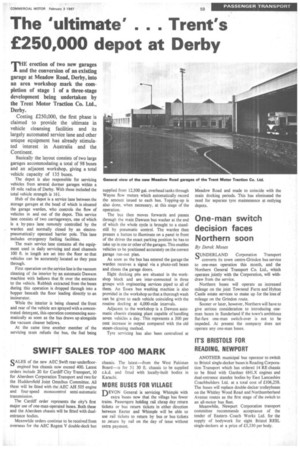The 'ultimate' . . . Trent's £250,000 depot at Derby
Page 61

If you've noticed an error in this article please click here to report it so we can fix it.
erection of two new garages
and the conversion of an existing garage at Meadow Road, Derby, into an area workshop mark the completion of stage 1 of a three-stage development being undertaken by the Trent Motor Traction Co. Ltd.,
Derby.
Costing £250,000, the first phase is claimed to provide the ultimate in vehicle cleansing facilities and its largely automated service lane and other unique equipment has already stimulated interest in Australia and the Continent.
Basically the layout consists of two large garages accommodating a total of 98 buses and an adjacent workshop, giving a total vehicle capacity of 135 buses.
The depot is also responsible for servicing vehicles from several dormer garages within a 10 mile radius of Derby. With these included the total vehicle strength is 161.
Hub of the depot is a service lane between the storage garages at the head of which is situated the garage warden, who controls the flow of vehicles in and out of the depot. This service lane consists of two carriageways, one of which is a by-pass lane remotely controlled by the warden and normally closed by an electropneumatically operated barrier pole. This lane includes emergency fuelling facilities.
The main service lane contains all the equipment used in daily servicing and steel channels 100 ft. in length are set into the floor so that vehicles can be accurately located as they pass through.
First operation on the service line is the vacuum cleaning of :he interior by an automatic Dawson machine with bellows that fit over the entrance to the vehicle. Rubbish extracted from the buses during this operation is dropped through into a hopper beneath the floor leading directly to an incinerator.
While the interior is being cleaned the front and rear of the vehicle are sprayed with a concentrated detergent, this operation commencing automatically as soon as the bus draws up alongside the vacuum cleaner bellows.
At the same time another member of the servicing team refuels the bus, the fuel being supplied from 12,500 gal. overhead tanks through Wayne flow meters which automatically record the amount issued to each bus. Topping-up is also done, when necessary, at this stage of the operation.
The bus then moves forwards and passes through the main Dawson bus washer at the end of which the whole cycle is brought to a standstill by pneumatic control. The warden then presses a button to illuminate on a panel in front of the driver the exact parking position he has to take up in one or other of the garages. This enables vehicles to be positioned accurately on the correct garage run-out plan.
As soon as the bus has entered the garage the warden receives a signal via a photo-cell beam and closes tha garage doors.
Eight docking pits are situated in the workshop block and are inter-connected in three groups with engineering services piped to all of them. An Essex bus washing machine is also provided in the workshop so that a thorough wash can be given to each vehicle coinciding with the routine docking at 4,000-mile intervals.
Adjacent to the workshop is a Dawson automatic chassis cleaning plant capable of handling seven vehicles a day. This represents a 300 per cent increase in output compared with the old steam-cleaning method.
Tyre servicing has also been centralized at Meadow Road and made to coincide with the main docking periods. This has eliminated the need for separate tyre maintenance at outlying depots.
















































































































































































